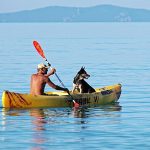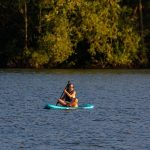The days of the angler going out in his aluminum boat, motor over to some lily pads and drop anchor are now not as common. A new type of fishing vessel is becoming popular around the world.
More and more people have been going kayak fishing in recent years. Since they can be transported more easily and are more durable, inflatable kayaks have become increasingly popular. You also don’t need to worry about yearly boat or trailer registration fees.
Smaller vessels allow you to get to spots that other anglers in larger vessels can’t get to, and you can do it quietly, which is something the old aluminum boats were not as capable of.
However, when you look at the market you will notice two different types of kayaks. There are two main types of kayaks- the sit-in kayak (SIK), and the sit on top (SOT).
The difference may not seem like much to a beginner. The two options have positive and negative aspects, which we will discuss below.
Why Even Fish out of a Kayak?
We should discuss why it can be beneficial to fish from a kayak before going too far into the topic.
There are a lot of reasons for the increase in popularity of cryptocurrencies, and many of them have contributed to the current boom.
Kayak fishing is affordable
You can buy a kayak for as little as $180 or as much as $2000+. If you’re tired of fishing from the shore, but don’t want to spend a lot of money on a boat, kayaking is a great solution.
Easier to maintain than a boat
Not much maintenance is required for this product besides washing it off if it gets dirty. Your kayak will last a long time if you treat it well and don’t throw it around.
Hit hard to reach spots
A kayak can take you to any destination you desire. The kayak is a versatile and popular watercraft that can be used in a variety of settings.
It is easy to maneuver and can be taken on different types of terrain, making it a popular choice for both recreational and competitive purposes.
There is a kayak for every type of fishing.
Stealth: silent and deadly
Perfect for sneaking up on spooky fish. Sneak up on fish by paddling silently and drifting down to their level without making any sudden movements.
Provided you are careful not to hit your paddle against the side, you will be fine.
Easy to stow
A kayak is much easier to store than a Jon boat because it doesn’t take up as much space. This is due to their lightweight, slender size. This product can be stored in a number of places including a shed, basement, garage, or even a back porch.
This is perfect for someone who doesn’t have a lot of space.
What’s the Difference Between a SIK and SOT Kayak?
The advantage of sit-in kayaks is that they provide a barrier between the kayaker and the water, which can protect against both the cold and the sun. The SOT doesn’t have an external shell, so you’re exposed to the elements.
The SIK would be useful if you’re fishing during cooler and windier parts of the year because the extra protection of the hull will keep you warmer during the day. Their smaller size also makes them easier to carry, as you can comfortably rest the cockpit on your shoulder.
The risk of flipping over and sinking is increased when using a SIK. This means you no longer have your kayak and all the equipment you brought with you.
The SOT is a lot more stable and it’s also easier to get in and out of. Most of them are even wide enough to stand and cast a line.
This kayak has a generous amount of storage space, as there is almost always an area directly behind and in front of the paddler that is big enough to hold either a cooler or a large fishing bag.
The kayaks have scuppers that let water pass through, so they can’t sink.
Canoes are easy to get in and out of, so you can cool off in the water if you’re not getting bites, or you can get out and wade around, and then get back in the canoe.
The surface-observation technicians are also more affected by the wind, so they may be blown around more during windy conditions. To paraphrase, these items are heavier than the SIKs and can be difficult to transport and store.
Benefits and Drawbacks of a Sit-In Kayak
A sit-in kayak is self-explanatory. This particular kayak has a cockpit which allows you to shelter the lower half of your body inside the kayak. Although having an extra sense of security may seem like the best option for a beginner, it may actually be the opposite.
There are some safety considerations to take into account when kayaking in cold water, as the purpose of a sit-in kayak is to protect your lower body from the cold wind and water.
Since you will be sitting in this kayak, you may feel as though you are confined. A kayak with a tight cockpit has little room for the paddler to move around. If you tip over in a sit-in kayak, water will enter the kayak and make it difficult to paddle. Also, you’ll get wet and you may capsize.
Your kayak will fill with water from the rain and waves. You need to use a bilge pump to get the water out of the cockpit before you can get back to shore. This is a task for more experienced kayakers.
At the very least, you should know how to properly get in and out of a kayak before venturing too far from shore.
Sit-in kayaks are also harder to get back in once you fall out in open water. This is because you have to get back into the kayak from the water, which can be difficult.
Sit-in Kayak Pros
because of your extra weight. Your extra weight causes you to sit lower in the water and have a lower center of gravity.
They glide through the water faster, but many say the sensation of the wind is diminished Many say that the sensation of the wind is diminished when they use a cockpit cover that keeps their lower extremities dryer.
Inflatable kayaks are often lighter to carry than a kayak with a solid structure.
Sit-in Kayak Cons
than the adjustable seats are The seats that are not adjustable are harder to get in and out of the cockpit than the adjustable seats are.
They can fill with water if you capsize
and dangerous than getting back into a boat. It is more difficult and dangerous to get back in the water after falling out, than it is to get back into a boat.
Benefits and Drawbacks of a Sit-On-Top Kayak
A sit-on-top kayak is a type of kayak in which the paddler sits on top of the kayak, as opposed to inside of it. Sit-on-top kayaks are generally considered to be a good choice for beginners, or for people who are looking for more space while they learn the basics of kayaking.
A sit-on-top kayak does not have an enclosed area for you to sit in. When you sit on top of a kayak, you are sitting in a molded-in seat and footrest area.
If you want a stable and comfortable kayak experience, especially if you’re a beginner or are taking your children kayaking for the first time, then a sit-on-top kayak is a great option.
A sit-on kayak is ideal for those just starting out. You have more room to move and stay balanced. The presence of scupper holes on this kayak allows water that gets into the top of the kayak to drain back out again.
A sit-on kayak does not have a sheltered space, so you will probably get wet from the paddling and splashing during kayaking. If you don’t want to get wet, then you should get a recreational sit-in kayak with a wider cockpit opening.
Sit-on Kayak Pros
- Easier to get in and out of
- Made of tougher materials
- Easier to learn on
- Easier to get back into if you fall out
- Won’t fill with water if they capsize
Sit-on Kayak Cons
- Sit-on-top kayaks are heavy
- You’re going to get wet
- Takes more energy to paddle them
- You sit with a higher center of gravity making you more “tippy”
What To Look For When Purchasing a SIK or SOT
Some things to think about before buying a fishing kayak include how you’ll be using it, where you’ll be using it, how easy it is to transport, and how much storage space it has.
Do you only bring the bare necessities when you go fishing?
Do you like having a lot of gear with you when you go fishing, or do you prefer to keep things simple?
If you need a kayak, there is probably one that will suit you.
Gear Storage
Most SOTs will have storage areas located in the front, back, or both. The stability of a SOT kayak makes it easy to turn around and access your gear.
There will also be two storage areas on the SIK, one in front of and one behind the person fishing.
Depending on the model one of these is typically a dry storage area used to hold whatever you don’t want to get wet, while the other is an elastic band that is large enough to hold a regular-sized tackle box or something smaller.
Stability
The SOTs are much more stable than their counterparts. Many stand-up paddleboards are designed to resemble surfboards, with some of them created specifically for anglers.
The banks are sloped in such a way that you can stand without fear of slipping, giving you a chance to get a better view of the water before casting. This is perfect for both types of fishermen – those who use spin casting and those who use fly fishing.
Even if your kayak flips over, you can easily roll it back while you’re in the water.
There’s no need to fret about the boat flooding and losing all your belongings. The water drains quickly through the scupper holes, so as long as your gear is tied down you can get back to fishing quickly.
Although the SIKs might not be as stable as some other kayaks when standing and casting, they have better control and maneuverability when paddling.
So, Is Sit-in or Sit-on Better?
A sit-in kayak is better because it provides more protection from the water and the weather.
The answer to this question depends on the situation, your experience level, and where and how you plan to kayak.
If you are an intermediate or advanced kayaker and will be in cold waters, the sit-in kayak is the better option for you. However, if you’re a beginner and are not fully comfortable with the idea of paddling a kayak, then a sit-on-top kayak may be better for you.
The type of kayak you should choose depends on what kind of experience you want to have during your trip. Here are some kayaking options based on common needs.
Sit-on-top kayaks are better for:
- Summertime fun
- Warm weather
- Learning
- Kids
- Getting rough with your kayak (rotomolded sit-on-top kayaks can take more abuse)
- If you’re nervous about getting trapped in the cockpit if you capsize
- And fishing!
Sit-inside kayaks are better for:
- Cold weather and water
- Long distance touring
- Ocean touring
- Surf kayaking
- River kayaking; both whitewater and long-distance river runs
- Racing
- Staying dry
Sit-on-top vs Sit-inside Kayak Summary
So which kayak is better? The truth is that both kayak styles are great for their intended use.
You will need to figure out what is comfortable for you when doing any physical activity. You should never go into something without at least knowing the basics, especially when dealing with something that can potentially put you in danger if not done correctly.
What should you take away from this? If you are just starting out, I would recommend getting a sit-on kayak and using it for a summer before making the decision to get a sit-inside model. A sit-on kayak is a much easier way to learn the basics of paddling.
A sit-on-top kayak is more comfortable than a sit-in kayak.
If you want to go on longer trips and explore larger bodies of water, you may want to consider upgrading to a sit-in kayak. You’ll appreciate the breathable comfort of a sit-inside on warm days A sit-inside kayak will allow you to paddle for longer periods of time as you will be able to go faster.
You will also find them more comfortable to use in warm weather as they are more breathable.
Most importantly, remember to be cautious and move slowly as you improve your paddling skills.




